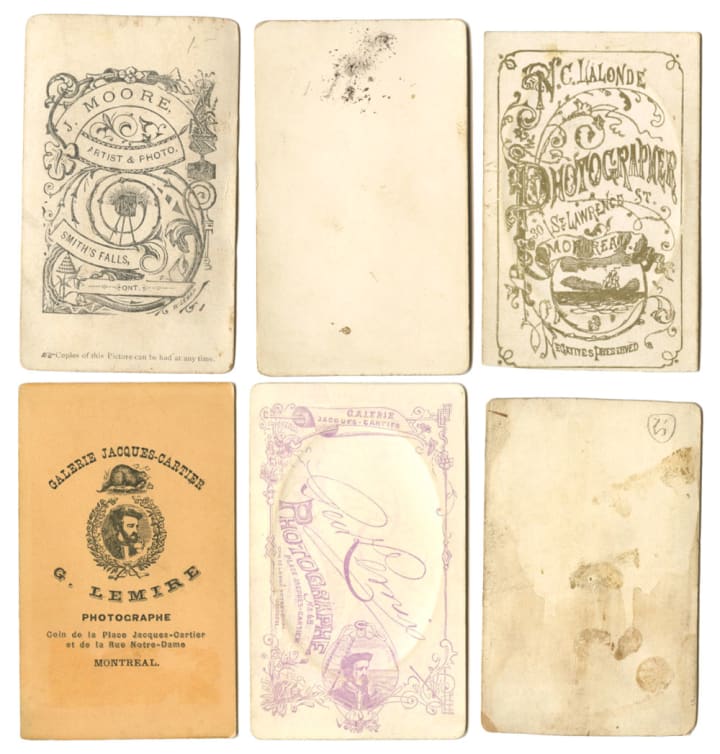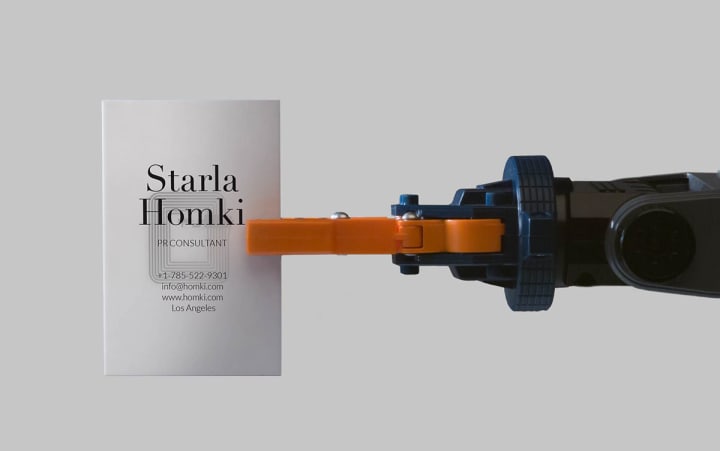Whatever Happened to the Business Card?
Presenting…Me! In today’s digital age, the business card is all but archaic. Should it be?

"Every dog has its day" as the old expression goes, which in the case of the humble business card means that it's "15 minutes of fame" has, rather remarkably, persisted for well over 400 years. There is reasonable historical evidence that the business card may have found its beginnings in China in the 1400s—certainly not in the form of a business card per se—but rather the means by which one identified him or herself.
In today’s digital age, our business cards seem to be our online footprint. Let’s take a look back on the history of the business card to see how we arrived to where we are today.
Historical Significance
Back to China in the 1400s – identifying oneself was particularly important in a rigid system where form was valued far more than function. Hierarchal structure, respect, and deference ruled the day.
Many of the Asian cultures treat business cards as an extension of the person. The cards themselves are treated with the highest respect. They are always presented with the right hand. They must always be in perfect condition (keep them in a proper case, not loose in your pocket) with no creases, dirt, or damage because otherwise that reflects directly on the person presenting the card.
Most importantly, when dealing with international cultures, they should have a translation on the reverse in the language of the person whom you expect to receive the card. Once it is in your possession, you must regard it, treat it respectfully and never just shove it in your pocket. North Americans and people from the UK are often guilty of not understanding these rituals, which can result in grievous insult, and the failure of business deals.
Not a Business Card?

Carte de visite portrait of Henry H. Halsey ca. 1855-95 via the Yale Collection of Western Americana
Once it arose in France in the 1600s, it was still not used for business—its function was entirely social. Called a carte de visite, or more formally, a visité billet, it was presented whenever members of high society attended the homes of their peers, or when they sought to create a new relationship with someone to whom they had not been introduced.
It was an intricate little ritual where the servant would answer the door holding a silver plate in the left hand. The guest would place their card upon the silver plate, and be instructed to wait until the intended recipient had reviewed the card.
If it was found to be satisfactory, then a meeting would be arranged. It might take place in the foyer, or in the parlor depending on the nature of the call. If no response to the card was forthcoming the visitor was expected to depart, presumably having been found unworthy to meet the lady or the master of the house.
Subtle Messages

6 Cartes de Visites via Media History
Over time additional flourishes to these rituals developed. For example, if the card were presented by a footman or a servant, while the visitor waited in his coach, the card was presented pristine. If the card was presented directly by the visitor, the top right corner of the card was folded over.
In another instance, if the card was presented with the intention to indicate that all of the members of the household were the reason for the visit, then a crease was created down the center of the card.
These cards were not small by any means so the folds obscured nothing. Often as large as a playing card, there was plenty of room to makes notes upon it, or cover it with artwork. The more intricate the artwork, the more likely it was to intrigue and convince someone that you are interesting enough to talk to.
Until the invention of the printing press, cards were manufactured with hand-carved woodcuts. One well-crafted woodcut would make hundreds of impressions.
If you were calling upon an individual, a single card would suffice, but if you were calling on a household that had several women members, each was expected to receive her own card. And even if you were already acquainted with the members of the household, you were still expected to place a card in another silver receptacle that stood on a table or stood inside the front door.
These cards formed a record of who had visited, and under what circumstance. This allowed members of the household to be aware of when return visits were required, thus allowing them to keep track of their social obligations.
In aid of that objective, a coding system was developed for the cards themselves. The codes started with the letter "p" to indicate pour (the French word "for") and between one and three additional letters, as laid out in the image below, indicating other "statuses".
In the instance where the notation is "p. f. N. A." there is a strong hint that this is the historical route from whence the idea of Valentine's Day and Christmas Cards came into being. Remember that crease down the middle, when intended for the entire family? In essence that turned it into four distinct pages, like our modern day greeting cards.
Increased Duties
Of course they weren't confined to France, and as they spread across Europe people found new uses for them. Most visiting cards were printed on just one side. This invited note taking on its blank back surface. Not just ordinary notes mind you, but promissory notes. You could literally "take it to the bank" and exchange it for money.
People could write contracts upon them, agreeing to provide a product or service. They could write brief letters of introduction so that one acquaintance might be "introduced" to a different acquaintance even when the intermediary wasn't present.
A New Contender

Trade Cards ca. 1881 via Vintage Ephemera
In England tradesmen began to use trade cards. They were not trying to emulate the upper class and "put on airs". Rather it was their way of dealing with a unique problem.
Streets may have had names on occasion, but there was certainly no numbering system. How could you tell someone where your place of business was? Simple! Create a card with your company name on it, perhaps a useful description, and on the reverse, print a map.
Newspapers of the day did not incorporate advertising. They were small circulation opinion sheets, much like the modern day blog, reflecting the opinion of one person, or a small editorial staff. They certainly weren't useful for tradesmen trying to build their customer base. Trade cards filled that gap.
Approximately the size of a postcard, they fit into the capacious pockets of the day, and served as handy reminders of how to locate a business you wished to deal with. You might even regard them as the precursors to business flyers.
Once businesses saw how effective they were, cards started to proliferate. The first two examples show signs that would hang outside of the shop so a potential client could recognize it. Beneath the image you see directions for locating the shop since there was no functional addressing system in existence.
The trade cards continued to evolve into even more ornate forms beginning with copper-engraving which allowed nearly photorealistic images. This inspired people to collect the cards and paste them into albums (is the term trading cards familiar to you?) which essentially allowed them to create a business directory that could be quickly referenced upon need.
It wasn't long before tinted versions started to become available, beginning a craze where even children were collecting these fascinating little pieces of ephemera.
Visiting cards to identify the individual soon began to blend and incorporate of some of the principles of trade cards. The business card was born!
The use of visiting cards remained purely social. Presenting a trade card however was indicative of your intention to collect on a bill. The business card could serve both purposes, indicating your status of owning a healthy business, as well as identifying you personally.
If you are familiar with cinema from the United States, you may also be familiar with the movie American Psycho. In one scene the differentiation between several equally titled "Vice Presidents" came down to the quality of their business card's paper stock, color, choice of font, and texture. The absurdity of the scene makes it worth taking a look, if you can spare less than three minutes of your time.
The Takeaway

RFID Cards via Moo
Ultimately your business card has a lot to say about you. In this modern age where so much of our communication is done electronically, the modest sophistication of a business card still delivers a personal touch. Some people even carry the second set of personal business cards for special clients offering exclusive e-mails, web addresses, or other information not commonly disbursed.
For those that want to combine aspects of both modern and traditional, there is a solution. Have a conventional card on the front, and on the rear, a QR-code that provides all of your information in an electronic format that can be scanned with any "smart" device.
QR-codes can provide quite varied information. It can be a digital business card, with all your vital contact information, which can be easily assimilated into a contact list on a smartphone. It can provide web addresses, links to sites, links to YouTube videos, a direct link to a Pay Now PayPal connection or just about any piece of information and you can imagine. This sample QR code links to the "American Psycho" video mentioned above.
All those business cards you have sitting around in desk drawers deserve a chance. Craft a single e-mail and send it to every single one that has an e-mail address. "Hi! I just found your card and thought I'd let you know that I am now [running my own business; working at Werner & Lowe; providing consulting; et al], and just thought I'd touch base with you to see if we could be of any use to each other. Feel free to drop me a line at your leisure." You might be surprised at the level of response.
Are business cards still a valid tool? I think so, but in the interest of fairness, here's a quick and funny video showing the exact opposite opinion.






Comments
There are no comments for this story
Be the first to respond and start the conversation.